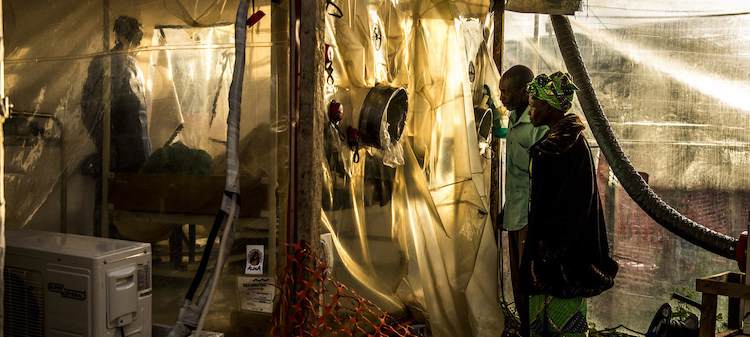
By Lisa Vives, Global Information Network
NEW YORK (IDN) – “We have no time to lose.” That’s the new mantra at the United Nations as the spread of the deadly Ebola virus in the eastern Democratic Republic of the Congo now appears almost unstoppable.
In a move to bolster efforts to contain the growing outbreak that has killed more than 1,200 people in 10 months, the United Nations on May 23 named David Gressly as the Emergency Ebola Response Coordinator (EERC).
“The Ebola response is working in an operating environment of unprecedented complexity for a public health emergency – insecurity and political protests have led to periodic disruptions in our efforts to fight the disease,” said Gressly, who also serves as the deputy chief of the UN Stabilization Mission for the DRC, MONUSCO.
Although the UN and non-governmental organizations (NGOs) have supported the Government and Congolese efforts to contain the virus in parts of Ituri and North Kivu provinces, ongoing insecurity and community mistrust continue to hamper access. This hinders the World Health Organization (WHO) and the Health Ministry from detecting, treating and vaccinating sick people, ultimately leading to more intense Ebola transmission.
According to UN News, the increasingly complex environment has prompted the UN, in partnership with the Government and others, to strengthen its political engagement and operational support to negotiate better access to communities; increase support for humanitarian coordination; and bolster preparedness and readiness planning for the Goma region, and neighbouring countries.
WHO is adapting public health strategies to identify and treat people as quickly as possible; expanding vaccination to encompass more people; and redoubling efforts to stem health facility transmissions.
Pointing out that “an enhanced UN-wide response is required to overcome these operating constraints”, Gressly underscored that “this includes moving senior leadership and operational decision making to the epicenter of the epidemic in Butembo”, where Secretary-General António Guterres has established a strengthened coordination and support mechanism.
Additional UN measures will strengthen the critical work of NGOs and agencies on the ground, including UNICEF, which is leading community engagement activities; providing psychosocial interventions, and helping to prevent infection through water, sanitation and hygiene services.
Moreover, strengthened financial planning and reporting will be accelerated to ensure the sustainable and predictable funding required to wage a strategic Ebola response plan.
“This system-wide and international support is exactly what WHO has been calling for”, said Ibrahima Socé Fall, the UN health agency’s Assistant Director-General of Emergency Response. Acknowledging that the outbreak response must be “owned by the local population”, he was heartened that the new approach reflects what has been asked for, namely “better security for patients and health workers, wider access to vaccination, and a more humane face to the response”.
Dr. Fall has been in Butembo since the end of March, working alongside the WHO Ebola Incident Manager, Dr. Michel Yao. In the capital Kinshasa, WHO has appointed Dr. Peter Graaff to coordinate with partners there. WHO will also continue to coordinate public health interventions that are being implemented by other UN agencies.
As EERC, Gressly will work closely with WHO and oversee the coordination of international support for the Ebola response and work to ensure that an enabling environment – particularly security and political – is in place to allow the Ebola response to be even more effective.
The drive to rein in the deadly virus has been hampered by attacks on treatment centers by armed groups operating in Congo’s lawless east as well as by distrust among local residents, many of whom view the disease as a conspiracy.
In addition, the WHO announced it discovered holes in its ring vaccination program which thwarted efforts to track down and vaccinate all exposed people.
“Somehow we have to catch up with the outbreak and break the transmission chain very quickly,” Congolese Health Minister Oly Ilunga Kalenga said, adding that a new approach was already been used in a few remote villages.
Kalenga said he preferred to use just one vaccine – Merck, not Johnson & Johnson. “It would perturb the population to be faced with several different types of vaccines and that would muddle the message, and, as you know in a complex outbreak response, the message needs to be simple and clear,” he said. Merck’s licensing process is underway, but it was unclear how long it would take.
Meanwhile, as the second-largest Ebola outbreak continues to spread, health officials say it is likely to reach the populous city of Goma. Once there, the risk of it spreading beyond the Democratic Republic of Congo to Rwanda, South Sudan, or Uganda increases. “I wouldn’t say (the spread to Goma) is inevitable, but it’s highly probable,” said Ray Arthur, director of the Global Disease Detection Operations Center at the U.S. Centers for Disease Control and Prevention. [IDN-InDepthNews – 28 May 2019]
Photo: Parents visiting her 15-year-old daughter, who is suspected of being infected by Ebola, at the Ebola Treatment Center in Beni, DRC (January 2019). Credit: World Bank /Vincent Tremeau.
IDN is flagship agency of the International Press Syndicate.
facebook.com/IDN.GoingDeeper – twitter.com/InDepthNews











